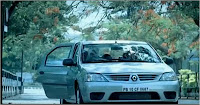Monday, July 05, 2010
Marketing Q&A : Marketing Career Vs Sales Career
Saturday, July 03, 2010
Brand Update : Logan Loves India

Wednesday, June 30, 2010
Oxemberg : Body Music


Saturday, June 26, 2010
Marketing Strategy : How to Market The Intangible
Marketing the Intangible
Originally Published in Adclubbombay.com
Services contribute about 5o% of India’s GDP and have become an important growth engine for our economy. The growth in the service sector has opened up immense opportunities for new products and also newer markets. The huge service economy of India has attracted many players into the market. The market is now flooded with new players and new products.
Marketing of services is a challenging task primarily because services are largely intangible in nature. Because of this intangible nature, consumers find it difficult to visualize the service or evaluate the quality of service before purchase. For established services this problem is less because customers already have formed their opinions because of their past interactions. For a new service firm, getting the customers to try out the service is a very difficult task. This calls for a strong branding effort on the part of the service marketer to lure the customers into their offerings.
Creating a service brand is not the task of the marketer alone. The entire organization is responsible for crafting that brand experience. This is because of the fact that service cannot be separated from the service provider. When the brand promises a consumer of a definite experience, the entire organization should be working as a single unit to provide that expected experience. People who are a part of the organization form an important element of the consumer’s perception about the service brand. For example, the behaviour of the cabin crew in an airline service is a critical factor that defines the perception of the consumers regarding that brand. Hence managing a service brand is more of a strategic function rather than a mere functional task.
For a consumer, evaluating a service before purchase is a difficult task. There is a strong element of risk which is perceived by the consumer before availing the service for the first time. Marketers’ task is to reduce the risk perception and encourage trust so that consumers try out the services. Many companies use branding as a tool to build trust and thus create a long lasting relationship with the customers.
Professor Leonard Berry in his article “Cultivating Service Brand Equity “in Journal of the Academy of Marketing Science” talks about four ways to build service brand equity. According to him, the service brand should be (a) Different (b) Determine your own fame (c) Make an emotional connection and (d) Internalize the brand. Strong service brands create powerful differentiators to convince the customers that they are different from the rest of the crowd. Service brands should also be very clear about their core strengths which will inturn makes customers to come back to their service offering. The brand should then build emotional connection with the consumers. Another important requisite is that the employees of the service organization should internalize the brand values and then only they will be able to provide outstanding customer service.
While communicating the service brand’s message, firms should be able to project its credibility, expertise and trustworthiness to the customers. Brands use characters, logo,symbols,colors etc to reinforce its service promise. ICICI Bank successfully used celebrities to build its image as a trustworthy new generation bank. Global consultancy firm Accenture firm uses Tiger Woods to convey its core brand value of “Performance”. These brands have used brand elements like slogans to reinforce the brand promise. Brands like Bajaj Allianz use characters to convey its message. Bajaj Allianz uses the animated “Super Agent “character to convey the message of reliable customer service. These brand elements help the customers to visualize the services even in the pre-purchase stage thus reducing the perceived risk of service failure.
Marketing a service require a holistic approach where the entire organization is focused at fulfilling the brand promise. It becomes the responsibility of every employee in the service organization to take part in creating the experience promised by the brand.
Tuesday, June 22, 2010
Sure : No Sweat

Saturday, June 19, 2010
Brand Update : Vivel Extending to Fairness Cream
